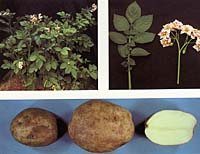Katahdin (Solanum tuberosum)
ORIGIN: Released by the USDA in 1932. Katahdin is one of the progeny of a cross between USDA 40568 X USDA 24642 and was tested as USDA 42667.
CHARACTERISTICS: The variety has main season maturity. Yielding ability is medium to high. This variety first gained prominence in the forties and maintained its position of major importance through the 1970’s. During this time, it was the major white-skinned variety in the Northeast because of its consistent performance. Katahdin is used primarily for tablestock.
Plants are medium in size, growing slowly at first, then developing rapidly with a somewhat open canopy. Stems, leaves, and petioles are dark green with slight purple pigmentation in the stems and petioles. Flowers are lilac with white tips. Pollen is abundant and fertile. For this reason and for its desirable characteristic, Katahdin appears in the pedigrees of many North American varieties. Tubers are round to oblong with buff, smooth skin and creamy white flesh. Lateral eyes are shallow and apical eyes are moderately deep. Specific gravity and cooking quality are medium. Dormancy is medium.
STRENGTHS & WEAKNESSES: Katahdin is susceptible to scab and resistant to mild mosaic, net necrosis and brown rot. It does not have a high degree of resistance to other major diseases, but neither is it especially susceptible to them. Tubers develop high in the hill and are subject to greening. Tubers are seldom misshapen, but may be irregular in shape under some growing conditions. The variety acquired its popularity because of its consistent performance under a wide range of conditions.
